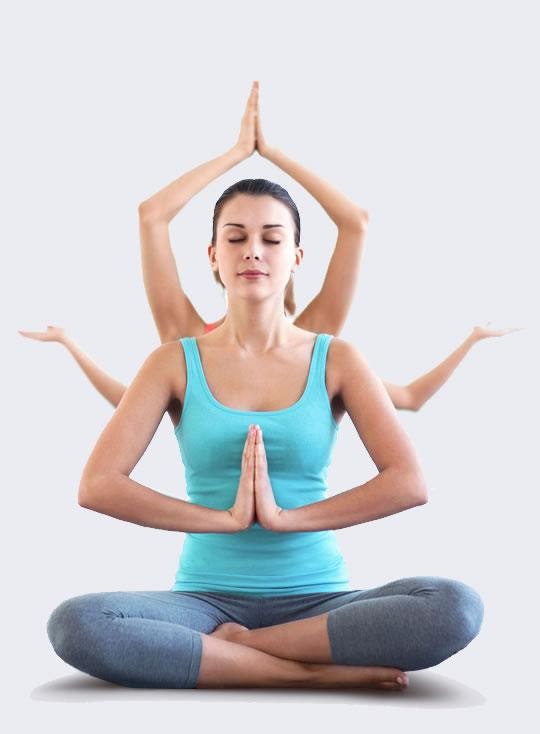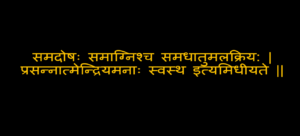
ROLE OF YOGA AND PRANAYAMA IN COVID-19
- May 24, 2021
- Posted by Dr. Vaidya Karanvir Singh
- 0 Comment(s)
Ayurveda Concept of Health-
- In Ayurveda Text, Health is defined as a state of Balanced Tridosha i.e. Vata, Pitta, and Kapha, Healthy Digestive fire, good state of all the body tissues and metabolic end products lead to a balanced state of senses, mind and spirit thus leading to a good Health.
- In Order to achieve the good state of health, Yogic principles help to strengthen and develop positive health and enabling us to withstand stress better.
- This pandemic has placed the world at risk, there is increased incidence of psychological distress and mental disorders. Yoga shows an amazing result in prevention of Covid 19 and lowers the post Covid symptoms found in patients.
- Some people diagnosed with COVID-19 experience prolonged symptoms that may last for weeks or months or possibly years after testing positive for the novel corona virus. They may have trouble in breathing, blood clots, headaches, nausea, muscle pain and fatigue.
- In order to strengthen the diaphragm and lungs, and prevent from the above mentioned symptoms and for happy, healthy life one should perform stretching (Asana or gentle movement coordinated with the breath) and some Pranayamas. This plays an important role for recovery.
- The following are the Yoga and Pranayamas that can help a lot in preventing this disease and its post term Negative impacts on mind and the body-
- Prathana Or Prayer –Yoga practices shall start with a prayer to enhance the benefit of practice.
- Yogasana-
- Surya Namaskara- One round of surya namaskar contains 12postures and one should hold each posture for 20seconds.
- It establishes proper basal metabolic rate in body and brings positive stimulation in endocrine glands. Its practice leads to proper blood circulation in whole body and hence increases our body immunity.
- Hamsasana – It opens up the chest region and increases lung capacity.
Indication – Asthma and other breathing disorders.
Contraindication- People with pain in knee should avoid this Asana.
- Bhadrasana- For strengthening of thigh muscles, vertebral column and beneficial for lungs.
Contraindication- Arthritis or Sciatica should avoid this Asana.
- Sirsasana – It is very effective Asana gives quick relief in Ocular diseases, graying of hair, Corzya and respiratory Catarrah. Contraindication- Persons with high BP, Migraine should avoid this Asana.
- Makarasana- This Asana increases the lungs capacity by expanding the chest region. As, it is a relaxing pose hence increase the parasympathetic activity in body.
- Setu bandhasana– It stretches and tones neck, back and chest reduce depression, stress, and anxiety and calms the brain. It Is also beneficial in high blood pressure, sinusitis, increases lung capacity, helps in sleeplessness, Osteoporosis and good for overall health.
Contraindication- In case of neck or back injury it should be avoided.
- Kapalbhati- It helps to improve pulmonary functions and reduces secretions. It awakens the dormant centers responsible for subtle cognizance and revitalizes the entire brain functioning. It is an amazing breathing exercise.
Indication- Daibetes, mood swings and minor anxiety, to stimulate abdominal organ, cleanses Lungs, Improves circulation.
Contraindication– High or low blood pressure, heart disease, hernia, gastric ulcer, epilepsy, vertigo, migraine headaches, significant nosebleeds, detached retina, glaucoma, history of stroke, and Abdominal surgery should advice your doctor or yoga expert before doing it.
- Pranyama –
- Nadishodhana Pranayama– It maintains body temperature, creates calmness in mind and improves concentration and focus. It provides sufficient oxygen to whole body that every cell functioning properly thus relaxing the whole body.
- Bhramari Pranayama –Nasal Nitric Oxide is increased by doing this pranayama, which may improve blood flow and has an anti-inflammatory action.
- Ujjayi Pranayama – It helps to increase the oxygen saturation in the body if done on regular basis.
- Dhyana –It induces mental awareness, stimulates the brain centers. It lowers the level of stress and anxiety, increases the vitality and provides nourishment of the whole body by extra supply of oxygen and improves the immune system of the body.
General Guidelines for Yoga Practice
- Yoga and Pranayama should be performed in a calm and quiet atmosphere with a relaxed body and mind.
- It should be done on an empty stomach or light stomach.
- You can take small amount of lemon in lukewarm water if you feel weak.
- Keep in mind that, the Bladder and bowels should be empty before starting Yoga and pranayama.
- The sessions should start with a prayer as it relaxes the mind.
- One should perform the Yogic kriya according to your own capacity.
- There are some contra-indications as mentioned above and limitations for each Yogic kriyas and one should always keep this in mind.
- Yogic Kriyas should end with meditation and deep silence so as to calm down your body and mind.
- Healthy and Satvik diet should be followed i.e. one should try to avoid meat, eggs, onion, garlic and mushrooms from their diet.
CAC POST COVID CARE PRODUCTS
- IMMUNOUP POWDER
- AMRIT TULSI RASA
- DIGESTION SUPPORT TABLET
- NERVE UP TABLET
- GILOY TABLET
For Details description of product Visit-
https://www.chandigarhayurvedcentre.com/product/after-corona-kit

Dr. Vaidya Karanvir Singh is the younger Vaidya in Chandigarh Ayurved & Panchakarma Centre. He is the fourth generation in his family who is practicing as a general consultant in Ayurved & Panchakarma treatment at Chandigarh. In his practice, he had treated more than 1 Lakh Plus patients worldwide.


